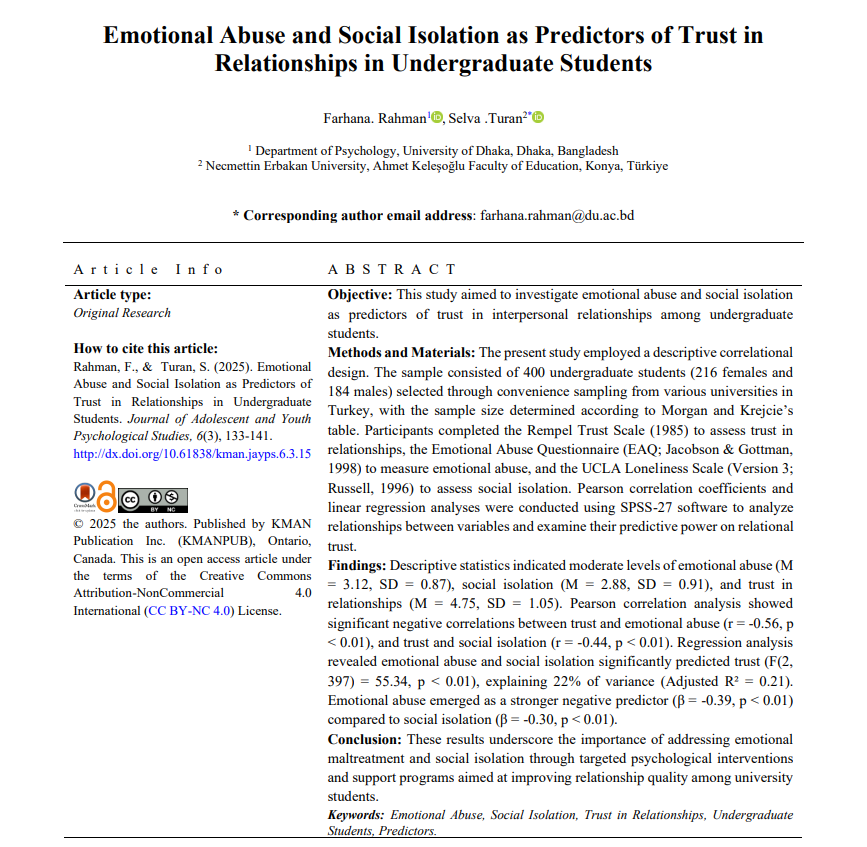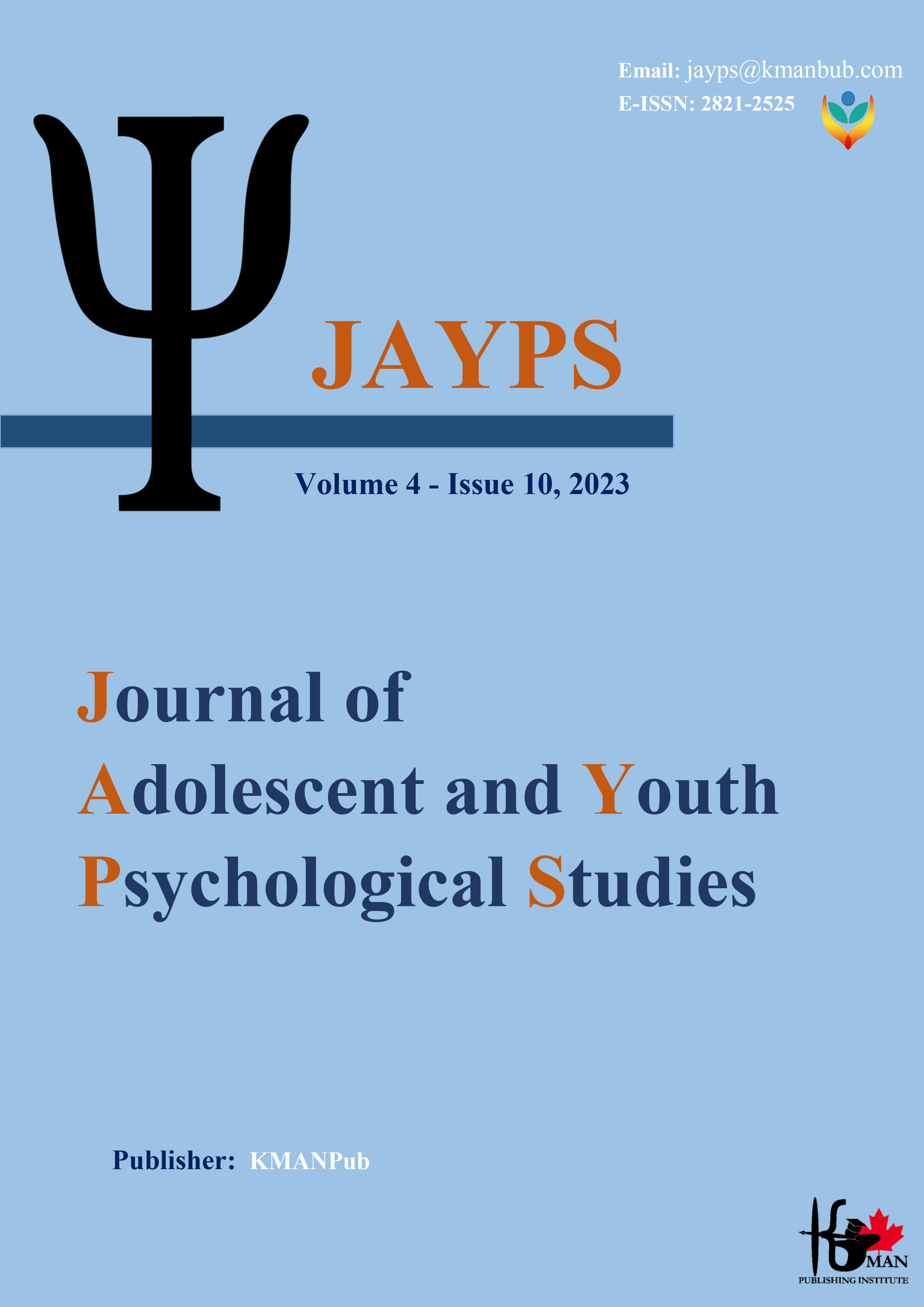Emotional Abuse and Social Isolation as Predictors of Trust in Relationships in Undergraduate Students
Keywords:
Emotional Abuse, Social Isolation, Trust in Relationships, Undergraduate Students, PredictorsAbstract
Objective: This study aimed to investigate emotional abuse and social isolation as predictors of trust in interpersonal relationships among undergraduate students.
Methods and Materials: The present study employed a descriptive correlational design. The sample consisted of 400 undergraduate students (216 females and 184 males) selected through convenience sampling from various universities in Turkey, with the sample size determined according to Morgan and Krejcie’s table. Participants completed the Rempel Trust Scale (1985) to assess trust in relationships, the Emotional Abuse Questionnaire (EAQ; Jacobson & Gottman, 1998) to measure emotional abuse, and the UCLA Loneliness Scale (Version 3; Russell, 1996) to assess social isolation. Pearson correlation coefficients and linear regression analyses were conducted using SPSS-27 software to analyze relationships between variables and examine their predictive power on relational trust.
Findings: Descriptive statistics indicated moderate levels of emotional abuse (M = 3.12, SD = 0.87), social isolation (M = 2.88, SD = 0.91), and trust in relationships (M = 4.75, SD = 1.05). Pearson correlation analysis showed significant negative correlations between trust and emotional abuse (r = -0.56, p < 0.01), and trust and social isolation (r = -0.44, p < 0.01). Regression analysis revealed emotional abuse and social isolation significantly predicted trust (F(2, 397) = 55.34, p < 0.01), explaining 22% of variance (Adjusted R² = 0.21). Emotional abuse emerged as a stronger negative predictor (β = -0.39, p < 0.01) compared to social isolation (β = -0.30, p < 0.01).
Conclusion: These results underscore the importance of addressing emotional maltreatment and social isolation through targeted psychological interventions and support programs aimed at improving relationship quality among university students.
Downloads
References
AkİŞ, A. D., & Öztürk, E. (2021). Patolojik Narsisizm: Duygusal İstismar Ve "Gaslighting" Perspektifinden Kapsamlı Bir Değerlendirme. Artuklu İnsan Ve Toplum Bilim Dergisi, 6(2), 1-31. https://doi.org/10.46628/itbhssj.1013622
Alade, A. A., & Oziofu, M. (2022). Emotional Abuse as Human Insecurity: A Myth or Reality? People International Journal of Social Sciences, 8(1), 01-16. https://doi.org/10.20319/pijss.2022.81.0116
Ali, P. I., & Yousaf, T. (2022). Emotional Dysregulation Among Young Adults: Relationship With Childhood Emotional Abuse. Pakistan Journal of Psychological Research, 37(4), 605-617. https://doi.org/10.33824/pjpr.2022.37.4.36
Amirmohammadi, M., Nikpeyma, N., Negarandeh, R., Haghani, S., & Majdabadi, Z. A. (2022). Relationship Between Emotional Elder Abuse and Developmental Function of the Family. Nursing Open, 10(4), 2485-2491. https://doi.org/10.1002/nop2.1505
Baig, A. T., & Riaz, Z. (2021). Tracing an Unyielding Work Compulsion: A Moderated Mediation Model of Abusive Supervision and Compulsory Citizenship Behavior. Frontiers in psychology, 12. https://doi.org/10.3389/fpsyg.2021.746823
Balcı, A., KİShali, Z., Aksu, F., & Kılıç, Z. N. A. (2023). Annelerin Çocukluk Dönemi Örselenme Durumları Ile Çocuklarıyla Olan İlişkilerinin İncelenmesi. Yüzüncü Yıl Üniversitesi Sosyal Bilimler Enstitüsü Dergisi(59), 184-204. https://doi.org/10.53568/yyusbed.1231882
Baúto, R. V., Carreiro, A. F., Pereira, M., & Almeida, I. (2021). Violence Risk Assessment in Forensic Psychology Office: From Childhood to Elderly. Annals of Medicine, 53(sup1). https://doi.org/10.1080/07853890.2021.1896198
Benzi, I. M. A., Carone, N., Parolin, L., Martin-Gagnon, G., Ensink, K., & Fontana, A. (2023). Different Epistemic Stances for Different Traumatic Experiences: Implications for Mentalization. Research in Psychotherapy Psychopathology Process and Outcome, 26(3). https://doi.org/10.4081/ripppo.2023.708
Canoy, C. F. (2025). Love of the Lotus: Exploring Romantic Relationships Among Adult Survivors of Childhood Sexual Abuse. Jip, 3(2). https://doi.org/10.69569/jip.2024.0660
Chen, C., & Duan, C. (2023). Emotional Abuse and Behavior Problems in Chinese Preschool-Aged Children: The Role of Hair Cortisol Concentrations. International Journal of Stress Management, 30(4), 333-340. https://doi.org/10.1037/str0000304
Fatima, I. (2025). Assessment of the Factors Influencing the Juvenile Delinquency. Abbdm, 5(1), 1-10. https://doi.org/10.62019/abbdm.v5i1.290
Finzi‐Dottan, R., & Abadi, H. Z. M. (2024). From Emotional Abuse to a Fear of Intimacy: A Preliminary Study of the Mediating Role of Attachment Styles and Rejection Sensitivity. International journal of environmental research and public health, 21(12), 1679. https://doi.org/10.3390/ijerph21121679
Fiolet, R., Brown, C., McKay, D., Marsden, S., Leins, K., & Harris, B. (2023). Perpetrator Perceptions on the Emotions and Motivations Driving Technology-Facilitated Abuse in Relationships: A Story Completion Study. Journal of interpersonal violence, 38(23-24), 11999-12024. https://doi.org/10.1177/08862605231190340
Guo, J. (2022). Analysis of Emotional Abuse in Adolescent Relationships. 166-172. https://doi.org/10.2991/978-2-494069-51-0_22
Hong, Y., Chen, M., Chen, C., & Qiu, M. (2024). Abusive Supervision and Nursing Students’ Intention to Leave the Nursing Profession: A Moderated Mediation Model of Emotional Exhaustion and the Nurse-Patient Relationship. BMC Nursing, 23(1). https://doi.org/10.1186/s12912-024-02025-5
Huey, C. n. W., Aziz, A. A. A., Hoesni, S. M., Razak, M. A. A., & Kamaluddin, M. R. (2021). Effects of Psychosocial Factors Towards Emotional Abuse Among University Students Who Have Been in Romantic Relationships. Educatum Journal of Social Sciences, 7(2), 107-120. https://doi.org/10.37134/ejoss.vol7.2.10.2021
Ju, L., Ji, Y. P., Wu, C., Ning, X., & He, Y. (2023). Relationship Between Abusive Supervision and Workers' Well-Being in Construction Projects: Effects of guanxi Closeness and Trust in Managers. Engineering Construction & Architectural Management, 31(8), 3429-3451. https://doi.org/10.1108/ecam-08-2022-0726
Kim, J. Y., Chae, H., Zhang, W., & Ahn, S. I. (2023). The Effect of Abusive Supervision on Supervisor Trust: Mediating Effects of Emotional Labor Strategies. Korean Academy of Leadership, 14(3), 65-95. https://doi.org/10.22243/tklq.2023.14.3.65
Kuruppu, J., Humphreys, C., McKibbin, G., & Hegarty, K. (2022). Tensions in the Therapeutic Relationship: Emotional Labour in the Response to Child Abuse and Neglect in Primary Healthcare. BMC Primary Care, 23(1). https://doi.org/10.1186/s12875-022-01661-7
Liu, P., Li, Y., Huang, J., Gao, X., Xu, Z., & Li, Y. (2024). The Relationship Between Emotional Abuse and Internet Addiction in Chinese Children: A Serial Multiple Mediation of Emotional Dysregulation and Regulatory Emotional Self-Efficacy. https://doi.org/10.21203/rs.3.rs-4137791/v1
Manurung, L. (2024). The Impact of Drug Abuse on Families and Society (Literature Review). MSJ, 2(2), 239-244. https://doi.org/10.61942/msj.v2i2.168
Morgado, B. J., Rodrigues, G. F., Filipe, M. R., Madureira, V. S., & Almeida, T. C. (2021). Traumatic Experiences in a Lifetime: Impact on the Connection With Others and the Role of Emotions. Annals of Medicine, 53(sup1). https://doi.org/10.1080/07853890.2021.1896197
Nazir, A., Omer, F. Y., & Baseer, A. (2023). Emotional Abuse, Emotional Regulation and Mental Health in Young Adults. HNJSS, 4(3), 122-134. https://doi.org/10.71016/hnjss/khn2qw73
Petersson, C. C., & Plantin, L. (2023). Overcoming Challenges of Intimacy: Male Child Sexual Abuse Survivors’ Experiences of Achieving Healthy Romantic Relationships in Sweden. Journal of family violence, 39(6), 1107-1120. https://doi.org/10.1007/s10896-023-00576-w
Rofifah, A. A., & Widyastuti, W. (2022). The Relationship Between Emotion Regulation and Emotional Abuse in Dating College Students in Bandung. Psikologia Jurnal Psikologi, 8. https://doi.org/10.21070/psikologia.v8i0.1698
Schoenmakers, E. C., & ten Bruggencate, T. (2024). Navigating loneliness: the interplay of social relationships and coping skills. International Journal of Adolescence and Youth, 29(1), 2339300. https://doi.org/10.1080/02673843.2024.2339300
Sy, V. R., Medellu, G. I. R., & Kusumawardhani, S. J. (2024). Peran Regulasi Emosi Dalam Perilaku Mencari Bantuan Pada Korban Kekerasan Dalam Pacaran. JPPP - Jurnal Penelitian Dan Pengukuran Psikologi, 13(2), 148-154. https://doi.org/10.21009/jppp.132.08
Yang, H.-j., & Lee, M. J. (2024). Assessing the Effectiveness of an Elder Re-Abuse Prevention Program Targeting Perpetrators. Social Welfare Policy and Practice, 10(1), 47-80. https://doi.org/10.37342/swpp.2024.10.1.47
Yılmaz, C. D., Lajunen, T., & Sullman, M. J. (2023). Trust in relationships: a preliminary investigation of the influence of parental divorce, breakup experiences, adult attachment style, and close relationship beliefs on dyadic trust. Frontiers in psychology, 14. https://doi.org/10.3389/fpsyg.2023.1260480
Zhou, X., & Shen, X. (2024). Unveiling the relationship between social anxiety, loneliness, motivations, and problematic smartphone use: A network approach. Comprehensive Psychiatry, 130, 152451. https://doi.org/10.1016/j.comppsych.2024.152451
Zhou, Y. (2024). Artistic Sports Activities Effectiveness for Enhancing Students’ Academic Performance Among Left-Behind Children: Mediating Effects of Loneliness. Frontiers in psychology, 15. https://doi.org/10.3389/fpsyg.2024.1366501

Downloads
Additional Files
Published
Submitted
Revised
Accepted
Issue
Section
License

This work is licensed under a Creative Commons Attribution-NonCommercial 4.0 International License.








